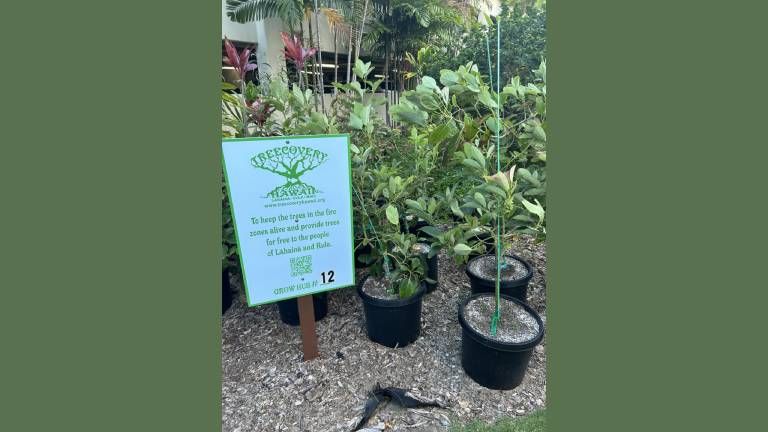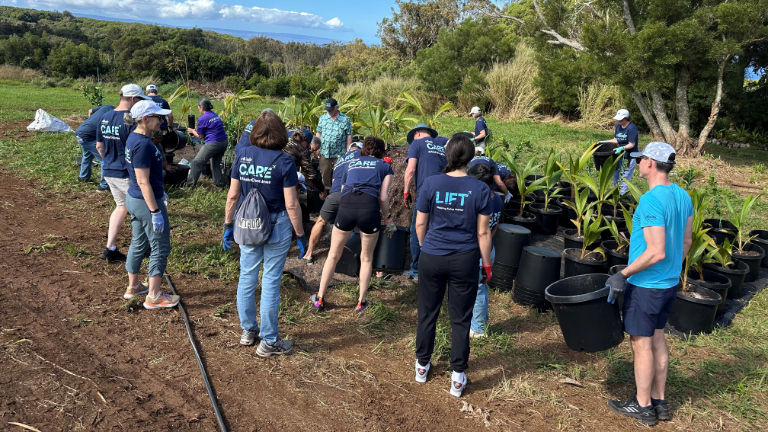On a recent trip to Maui, I was confronted firsthand with the devastation in Lahaina by the historic wildfires of August 2023. From the road, seeing the ghost of the beloved town — which I was fortunate to visit a handful of times over the years — was heartbreaking, though signs of the ongoing cleanup and the start of rebuilding were certainly reassuring.
What really heartened me, however, was seeing the ways in which the local Maui community has come together to support ongoing recovery efforts — in some cases, with help from stakeholders in the tourism industry.
During my November 2024 stays at Kaanapali Beach’s Sheraton Maui Resort & Spa and Hyatt Regency Maui Resort & Spa, I learned that both properties have been working with Treecovery Hawaii, a local nonprofit that sprung up to keep trees alive in the fire zones and provide free trees to residents who lost their homes and business. The two hotels, and others on the island, have been housing potted trees as they start to grow, until residents are able to rebuild, return home and plant them.
 Sheraton Maui Resort & Spa serves as a Treecovery grow hub.
Sheraton Maui Resort & Spa serves as a Treecovery grow hub.
Credit: 2025 Kelly Rosenfeld
“Once the fire happened, we got a lot of inquiries to [the Arborist Committee for Maui County] about what’s happening with surviving trees, what’s happening with the banyan tree [in Lahaina] and the plan on rebuilding,” said Duane Sparkman, chairman of the Arborist Committee for Maui County, and the founder of Treecovery. “As chairman, it all came to me. So, we started answering those questions and devising a plan of what we could possibly do.”
Sparkman says a sponsorship with a platform called TreePlotter let the team identify and plot surviving trees using GPS, so they could be watered and monitored, in what he calls the “first phase” of the operation. Next, Sparkman and his associates began collecting data from landowners about the trees that were lost to the fire, so they could have those trees available to residents when it came time to replant their properties.
Of course, in order to provide this service, Treecovery needed places to grow the potted trees for extended periods of time.
“It became this big thing with the hotels, and that started with the Marriott Vacation Club in Kaanapali,” Sparkman explained. “I had gone to the general manager’s house, not knowing he was the general manager, to do an assessment of his trees.”
When Sparkman told him about Treecovery, the general manager offered to house trees in the lobby of the hotel to support the initiative.
“A lightbulb went off,” Sparkman said of that moment. “It was like, ‘OK, if it’s in your hotel, I could probably get other hotels to help, too.’ We started asking around, and more properties agreed.”
When I spoke to Sparkman last December, Treecovery was partnering with about eight hotels, with talks of adding three more early in the new year. And, he says, there are multiple benefits to working with the resorts — for both sides.
For one thing, having space to grow some 5,000 trees (the count at the time of our conversation) with no overhead costs allows Treecovery to deliver more mature plants that will provide shade and, in some cases, fruit, immediately upon being planted at new homes and businesses, helping residents feel more comfortable and established.
 Volunteers from Alaska Airlines/Hawaiian Airlines, Treecovery’s newest partner, have helped pot trees.
Volunteers from Alaska Airlines/Hawaiian Airlines, Treecovery’s newest partner, have helped pot trees.
Credit: 2025 Treecovery HawaiiOn the hotel side, Sparkman (who is also the full-time chief engineer at Royal Lahaina Resort & Bungalows) says that the partnership demonstrates to employees — many of whom were impacted by the fires — that their company cares. Having the trees on property also encourages awareness among visitors.
Tourists can see that we’re growing trees for the future and trying to work for the greater good. And they can donate if they want to help with the healing process.
“Tourists can see that we’re growing trees for the future and trying to work for the greater good,” Sparkman said. “And they can donate if they want to help with the healing process.”
Other Ways Treecovery Is Assisting With Wildfire Recovery
Treecovery’s other initiatives include partnering with local artists and craftspeople on pieces to be sold at fundraisers (some of which are made from wood burned in the fires), which helped the nonprofit raise some $400,000 over a six-month period. Those funds go toward infrastructure, water and the trees themselves, which are bought at full price from local vendors to help keep nurseries in businesses.
Another partnership with Lahainaluna High School is working toward letting local kids be part of the rebuilding process through school curriculum.
“It’s the kids who really need help and direction right now, because they don’t have any input in the rebuilding process,” Sparkman explained. “Their friends are displaced around the island. Their families may not be stable. They don’t necessarily have permanent places to live right now. If we can give them some responsibility toward this rebuild, we believe that will make a huge difference in their lives. And we proved that in our first meeting with 10 kids from Lahainaluna, who [demonstrated that they] really want to help.”
As if all these diverse benefits weren’t enough, Treecovery’s work also stands to make Maui’s environment — as well as its community — stronger and more resilient.
“This project checks all these boxes, from the cultural side to soil erosion mitigation to fire mitigation to watershed assistance,” Sparkman said. “And everyone is kind of part of the recovery, because we can utilize all of their information and their volunteered time to push this forward. It’s all just done with love.”